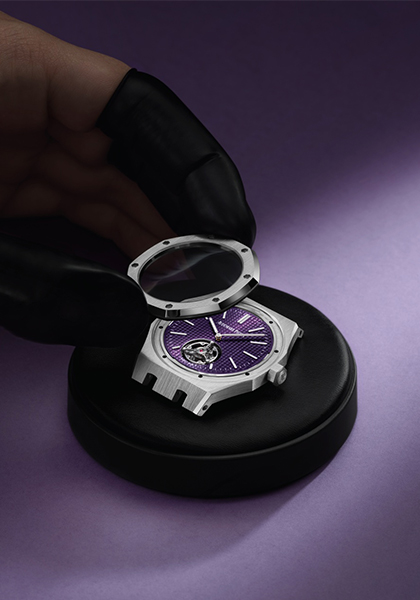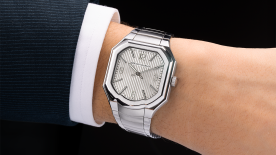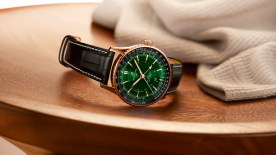When we think of the established frontiers of horological superlatives — the most complicated watch, the loudest repeaters, the highest balance frequencies, the thinnest movements — we associate them with concerted mechanical assemblies or groundbreaking advances in material technology, with complex implementations accompanied by grand announcements and fanfares. Occasionally, however, something quietly revolutionary comes along and unlocks a new realm of possibility. Something so logical, straightforward and conceptually pure that you wonder why no one did it before. Something like the revised lever escapement on the Audemars Piguet Royal Oak Selfwinding Flying Tourbillon Extra-Thin (RD#3).
You must be asking yourself, what on earth is Suzanne talking about? What revised lever escapement? What’s so amazing about it? And if it’s so special, why haven’t we heard about it before?

I mean, an essential part of what journalists do is bring news (that is, stuff that you hadn’t heard of before) to your attention, so I feel like that fourth question is kind of moot. And regarding the first three questions, the official communication from Audemars Piguet specifically mentions that the RD#3 has a new escapement with “an oscillator with increased amplitude”. That one brief phrase should immediately draw the attention of anyone with an interest in technical watchmaking, even though there’s very little further elaboration on this. It’s an incredibly tantalising phrase to dangle before someone like myself; like a cat with a ball of yarn, I have a pathological urge to unravel this mystery.
What does it mean to have “an oscillator with increased amplitude”? It means the balance is able to rotate through a greater angle on each half-swing. It means the balance is inherently more stable, more efficient, and less vulnerable to external perturbations (such as shocks). In short, it makes for a better watch. When I spoke with Giulio Papi, technical director of Audemars Piguet Le Locle, he explained just how the oscillator in the cal. 2968 inhabiting the Royal Oak RD#3 can exhibit amplitudes of just under 360° per half-swing.
Now, this goes against everything we know about the optimal functioning of a balance wheel. We’re told — it’s drilled into our understanding of watchmaking’s fundamental principles — that the ideal balance amplitude lies between 270° and 320°. Any less, and the regulating organ becomes prone to error; any more and the problem known as “knocking” starts to present itself, interfering with the optimal function of the regulating organ. (For the nerds among us, “knocking” describes the phenomenon where the impulse pin comes into contact with the outer surface of the pallet fork, interfering with the smooth operation of the balance and diminishing the chronometric ability of the watch.)
At this juncture, we find ourselves at the periphery of an extremely convoluted problem, and you can skip the next two paragraphs if the technical side of watchmaking doesn’t interest you. The maximum amplitude achieved by a balance has two constraints, energy and geometry. If the impulse pin is struck with sufficient force, the balance is able to rotate further and thus exhibit larger amplitudes — that’s just common sense. Past a certain point, however, even if you keep increasing the force applied to the impulse pin, the balance amplitude remains the same — the balance can’t rotate any further because it is physically stopped by the pallet fork.

If you want to further increase the maximum amplitude of the balance, you have to increase its angle of lift, which is generally frowned upon, because it messes with the isochronism. Given the additional stability that is afforded by the increased amplitude, however, that may be an advantage worth trading for. In general, the operation of the escapement itself causes the watch to lose anyway. It can’t be helped, as this loss is inherent to the mechanism — a built-in cost, we might say. The lower the amplitude, the greater the loss, and that’s before we’ve even factored in the increased vulnerability of a low-amplitude balance. When you start tallying up the pros and cons of increasing balance amplitude, the reconfigured escapement geometry of the Royal Oak RD#3 seems logically inevitable.
Unsurprisingly, this innovation arose from another exceptional project handled by Audemars Piguet Le Locle, the Richard Mille UP-01, which integrated several innovative features in its successful pursuit of the world record for ultra-thin watchmaking.
You’ll hear jaded collectors and industry insiders question the utility of pursuing records. “What’s the point of the Richard Mille RM UP-01?” They ask. “World’s thinnest watch; okay, good for them, but the watch just isn’t wearable!” But the point of watches like the RM UP-01 is not necessarily for them to be worn. Watches like the RM UP-01 function less as watches and more as keys. They unlock those realms of possibility I talked about at the beginning of this article.
The record itself isn’t that important. There are very few people who will actually get to wear or own the world’s most complicated watch, or the world’s loudest minute repeater, or the world’s thinnest watch. Records are mostly important because of how they allow the body of watchmaking knowledge to grow.
Improvements and advancements in chronometric savoir-faire have historically been spearheaded by innovations in the realm of compact watchmaking, so it’s evident to any big-picture observer of horology that the impact of the Royal Oak RD#3 (and, naturally, the RM UP-01) will have a far bigger reach than initial appearances might suggest. And as mechanically fascinating as the Audemars Piguet Royal Oak RD#3 is in its entirety, it is the one tiny part at the heart of the timepiece — the escapement — that will continue to nourish the domain of innovative watchmaking at Audemars Piguet for years to come.







